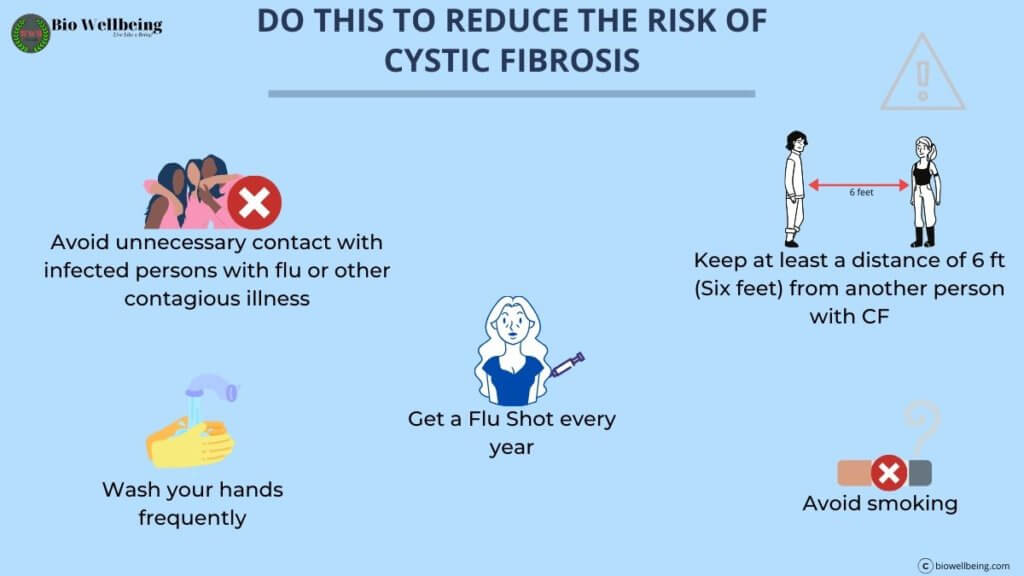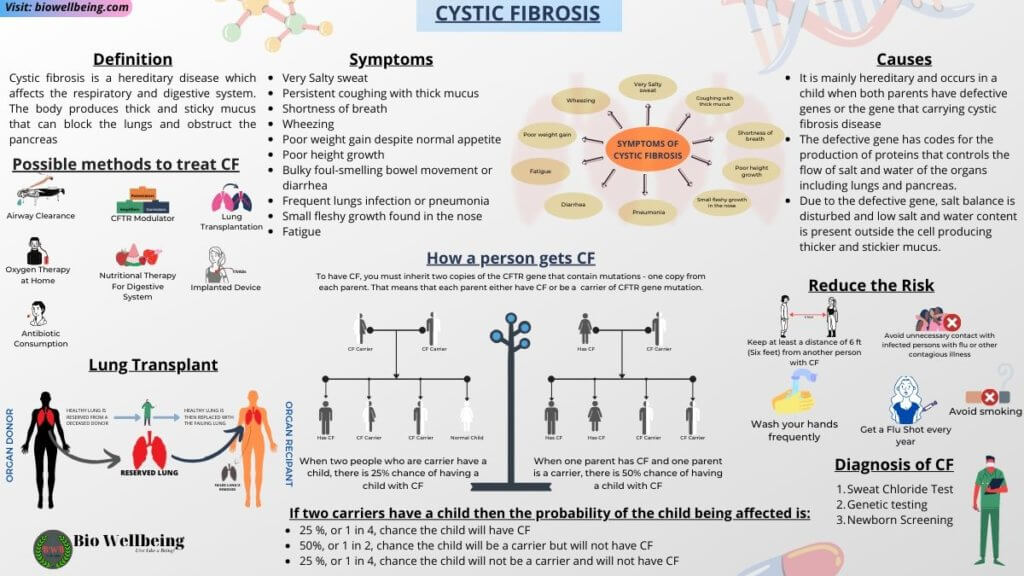POST CONTENTS
What Is Cystic Fibrosis?
Cystic fibrosis is a hereditary disease which affects the respiratory and digestive system. The body produces thick and sticky mucus that can block the lungs and obstruct the pancreas.
The defective gene leads to the production of thicker and stickier mucus than usual which is hard to cough out of the lungs. It may lead to difficulty in breathing and severe lung infection along with male infertility, malnutrition, respiratory failure.
It is life-threatening and people with this disease might have a short-life span.
Currently, there is no cure for CF but a lung transplant can do the job in which someone may live into the 30s,40s or beyond.
75% of people diagnosed every year include most of the kids below the age of 2years.
CF can be fatal when people with diabetes and liver disease encounter it.
What Are The Symptoms Of Cystic Fibrosis?
The CF symptoms might vary person to person. Some people may not experience these CF symptoms until their teenage or adulthood.
There are many cf symptoms. But, these are the most common cf symptoms which we should look into:
- Very Salty sweat
- Persistent coughing with thick mucus
- Shortness of breath
- Wheezing
- Poor weight gain despite normal appetite
- Poor height growth
- Bulky foul-smelling bowel movement or diarrhea(because of poor digestion of food)
- Frequent lungs infection or pneumonia
- Small fleshy growth found in the nose
- Fatigue
These cystic fibrosis symptoms might vary from person to person. These CF symptoms or signs may worsen or improve as time passes.
People who are not diagnosed until adulthood usually have milder diseases. They may experience atypical symptoms such as pancreatitis, infertility, and recurring pneumonia.
Other than this, the respiratory signs are the best CF symptoms, such as persistent coughing, thick mucus, lung infections, pneumonia and shortness of breath etc.
Some CF symptoms come under the digestive signs like diarrhea, foul-smelling, and greasy stool etc.
Other CF symptom which is most common particularly in newborns is the intestinal blockage.
These are the most common CF symptoms which we should look into.
What Are The Causes Of Cystic Fibrosis?
It is mainly hereditary and occurs in a child when both parents have defective genes or the gene that carrying cystic fibrosis disease.
The defective gene has codes for the production of proteins that controls the flow of salt and water of the organs including lungs and pancreas.
Due to the defective gene, salt balance is disturbed and low salt and water content is present outside the cell producing thicker and stickier mucus.
How Cystic Fibrosis Is Inherited?
Cystic fibrosis is an inherited disease caused by a mutation of a gene called Cystic fibrosis transmembrane conductance regulator gene (CFTR gene).
CFTR gene controls the flow of salts and fluids in and out of the cells. If the CFTR gene doesn’t work the way it should, sticky mucus builds up in your body.
If someone has cf then it means that both of the parents have inherited the mutated copy of the gene to the child.
99% of people who are affected with CF have at least one copy of the mutational CFTR gene.
If someone inherits only one copy of the CFTR gene then the person is not affected but he/she becomes the carrier of this genetic disease which is called cystic fibrosis.
It is an autosomal recessive disease.
If two carriers have a child then the probability of the child being affected is:
- 25 %, or 1 in 4, chance the child will have CF
- 50%, or 1 in 2, chance the child will be a carrier but will not have CF
- 25 %, or 1 in 4, chance the child will not be a carrier and will not have CF
How Cystic Fibrosis Is Diagnosed?
Sweat chloride test: The commonly used test is the sweat test. Sweat testing involves the application of a medication that stimulates sweating (pilocarpine).
To deliver the medication through the skin, iontophoresis is used, whereby one electrode is placed onto the applied medication and an electric current is passed to a separate electrode on the skin.
The resultant sweat is then collected on filter paper or in a capillary tube and analyzed for abnormal amounts of sodium and chloride.
People with CF have increased amounts of them in their sweat.
Genetic testing: CF can also be diagnosed by the identification of mutations in the CFTR gene
Newborn screening: The newborn screen initially measures for raised blood concentration of immunoreactive trypsinogen (IRT).
Infants with an abnormal newborn screen need a sweat test to confirm the CF diagnosis. In many cases, a parent makes the diagnosis because the infant tastes salty.
Immunoreactive trypsinogen levels can be increased in individuals who have a single mutated copy of the CFTR gene (carriers) or, in rare instances, in individuals with two normal copies of the CFTR gene.
Due to these false positives, CF screening in newborns can be controversial.
Is There Any Treatment for Cystic Fibrosis?
Currently, there is no cure for CF. Treatments can manage CF symptoms and improve the quality of life.
While no cures for CF are known, several treatment methods are used.
The management of CF has improved significantly over the past 70 years. While infants born with it 70 years ago would have been unlikely to live beyond their first year.
Infants today, are likely to live well into adulthood.
Possible methods which can be used for the treatment:
Airway clearance: It helps the CF patient to get rid of thick mucus formed inside the lungs to avoid further infections and it allows clear breathing.
An example of ACT would be postural drainage and percussion. A therapist claps the CF patient’s chest and back while they sit, stand, or lie in a position that should help to free up mucus.
Implanted devices: It can allow long-term access to the bloodstream for the frequent and regular administration of drugs. They can make the management of a chronic condition like CF more efficient and less intrusive.
CFTR modulators: These are new medications used to target the faulty CF causing gene. It allows a sufficient flow of salt and fluids on the surface of the lungs.
It makes the thick mucus, inside lungs, thin. their lungs. Two CFTR modulator brands are currently approved by the Food and Drug Administration (FDA). These are Kalydeco and Orkambi.
They are prescribed for children with 10 different mutations of the CF-causing gene. Kalydeco may be prescribed from the age of 2 years onwards, and Orkambi at 6 years
Nutritional therapy for digestive symptoms: CF can affect digestion and the CF patient should consult a dietitian or doctor.
A different kind of diet or additional supplements, such as pancreatic enzyme supplements, salt, or vitamins, may be needed to balance the absorption of nutrients.
CF can lead to impaired growth. A high-calorie, high-fat diet is essential for normal growth and development in children with CF.
It can help adults to maintain optimal health. Good nutrition is vital to maintain a defense against an increased risk of lung infection
Transplantation: It is necessary for the CF patient when their lungs become dis-functional and exercise tolerance declines.
Both of their lungs need to be transplanted because the remaining bacteria in the left out lung can cause disease in the transplanted one.
Lung transplantation is considered when lung function declines to the point where assistance from mechanical devices is required or someone’s survival is threatened.

Oxygen therapy at home: It’s for people with a significantly low oxygen level. Mostly used for treating the lung damage caused by thick mucus and infection.
In this therapy, the cf patient consumes pure Oxygen. The cf patient uses an oxygen mask or a pipe in their nose.
CF patients usually use them at night when they are sleeping. It should be assured that they are getting sufficient oxygen during their sleep.
Antibiotics consumption: People with cystic fibrosis are always on one or more antibiotics even if they are healthy. They need this to suppress the infection.
Antibiotics are necessary when there is the detection of pneumonia or lung health declination.
Inhaled therapy with antibiotics such as tobramycin, colistin, and aztreonam is often given for months at a time to improve lung function by impeding the growth of colonized bacteria.
Inhaled antibiotic therapy helps lung function by fighting infection, but also has significant drawbacks such as the development of antibiotic resistance, tinnitus, and changes in the voice.
Oral Antibiotics such as ciprofloxacin or azithromycin are given to help prevent infection or to control ongoing infection in the CF patient.
How to Reduce The Risk Of Cystic Fibrosis?
People with CF should follow these steps:
- Washing hands frequently
- Get a flu shot every year
- Avoid smoking
- Avoid unnecessary contact with infected persons with flu or other contagious illnesses
- keep at least a distance of six feet from another person with CF. (Because the bacterial disease can spread from contact. So It’s necessary to avoid contact with another person with CF otherwise both will get infected. These bacterial infections can transfer to each other and that can be lethal too)
Burkholderia cepacia:
Apart from all these things one dangerous disease exists which is deadly than normal CF. It is called the Burkholderia cepacia complex.
The B.cepacia or Burkholderia cepacia is an opportunistic pathogen that causes pneumonia in persons having very low immunity and undergoing lung diseases like Cystic fibrosis.
Burkholderia cepacia pathogens are resistant to many antibiotics so it makes them difficult to treat after it infects the lungs.
Some can be treated easily with a different combination of antibiotics intake. In this case, even lung transplantation is not that easy if antibiotics resistance is there.
If the given antibiotics work properly on you then only doctors prefer to do a lung transplant
Conclusion:
This is a disease where chances of getting infected is more and so you should avoid contact with people unnecessarily. Take all the preventive measures to prevent any kind of complicacy.
Stay in touch with medical personal for any emergency. Eat healthily, do exercise to increase breathing capacity.
You can also watch the movie Five feet apart, it also has some information about people with CF and Burkholderia cepacia. You may find it interesting. Not all the information shown there is clinically right but you can refer to our page for authentic information about it
Infographics Of Cystic Fibrosis:
Good Luck & Stay Healthy!
References:
- https://kidshealth.org/en/teens/cystic-fibrosis.html
- https://kidshealth.org/en/teens/cystic-fibrosis.html
- https://www.sciencedaily.com/releases/2012/04/120422162413.htm
- https://www.cff.org/Life-With-CF/Daily-Life/Germs-and-Staying-Healthy/What-Are-Germs/Burkholderia-Cepacia-Complex/
- https://en.wikipedia.org/wiki/Cystic_fibrosis
- https://www.medicalnewstoday.com/articles/147960#treatment
Also Visit:
- Red Rice for Diabetes: Unlocking the Potential of a Nutritious Grain!
- Study Finds Steady Demand For Counseling Services During COVID-19 Despite Telehealth Switch
- Microplastic & Nanoplastic Harms the Brain: Research Talk
- Rise of Gene and Cell Therapy in India: Harnessing the Power to Revolutionise Medicine
- The Rise of Telehealth in Georgia: How It’s Changing Healthcare Delivery?





